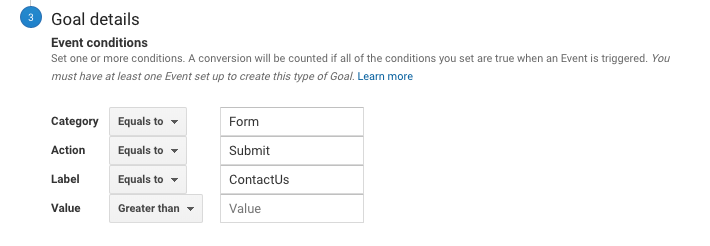Demystifying Google Analytics Limitations: Discover What Data Goals Can not Track
In the world of electronic analytics, Google Analytics stands as a powerful tool that offers beneficial understandings right into website performance and user actions. Nevertheless, among its abilities, there exist constraints that often go undetected. Comprehending what Google Analytics can not track is essential for an extensive grasp of data analysis and decision-making processes. From the details of user communication with vibrant web content to the complexities of cross-device customer trips, these limitations lost light on locations that might stay covered from standard analytics point of views. By unraveling these restrictions, a more clear image emerges, allowing for more informed approaches and refined understandings into user engagement and conversions.

Individual Communication With Dynamic Web Content
Individual communication with vibrant web content plays a vital duty in understanding individual habits on internet sites and optimizing the overall user experience. By tracking customer interactions with vibrant material, internet site proprietors can acquire beneficial insights into user engagement, choices, and habits - what data is google analytics goals unable to track.
Google Analytics uses different tools to track individual communications with dynamic content, such as event monitoring and online pageviews. Occasion tracking allows you to monitor certain individual actions, like clicking a button or enjoying a video, offering information on exactly how users engage with dynamic elements.
Cross-Device User Journeys
Exactly how can modern analytics devices track the complex courses users take across multiple tools in their on-line journeys? Cross-device user trips provide a significant obstacle for monitoring and assessing user actions accurately. As users communicate with apps or web sites using numerous devices such as desktops, tablet computers, and smart devices, it comes to be crucial to recognize how they move between these systems to maximize user experience properly.
Google Analytics faces limitations in tracking cross-device user journeys due to personal privacy problems and technological constraints - what data is google analytics goals unable to track. While it can provide understandings right into private tools' communications, tracking a smooth user journey throughout numerous tools remains a difficulty. This constraint can lead to incomplete data and fragmented customer insights, making it challenging for businesses to develop a unified sight of the consumer trip
To address this concern, services can utilize sophisticated analytics devices that supply cross-device tracking capacities, enabling them to acquire a much more holistic understanding of user habits. By leveraging these tools, businesses can bridge the void in tracking cross-device individual trips and optimize their digital methods for a smooth customer experience.
Offline Conversions and Acknowledgment
As businesses browse the difficulties of tracking cross-device individual trips, one more pivotal facet to think about is the world of offline conversions and attribution in the world of data analytics. While Google Analytics provides valuable insights right into online user actions, it fails when it involves tracking conversions that occur offline. This constraint postures a significant obstacle for services that have both online and offline sales channels.
Offline conversions, such as purchases made in physical shops or via phone call centers, are necessary to comprehending the total client journey. Without the capacity to connect these offline conversions to details on the internet communications, organizations might battle to accurately determine the impact of their digital advertising initiatives.
To resolve this space, services can check out different options such as incorporating CRM systems with on the internet analytics tools or using one-of-a-kind promotion codes that can be traced back to on the internet projects. By bridging the void in between online and offline data, companies can obtain try this website a more comprehensive understanding of their clients' behavior and enhance their general advertising strategies.
Person Individual Recognition
In the world of information analytics, the capability to accurately recognize private customers throughout various on the internet touchpoints is a critical obstacle for organizations looking for to personalize and enhance their advertising and marketing techniques. While Google Analytics offers beneficial insights into individual actions and interactions, it falls brief in allowing the recognition of specific people because of privacy issues and technical limitations. Google Analytics utilizes special identifiers such as cookies to track customer sessions and behavior, but these do not relate to recognizing private customers in an individual sense.

Information From Secure Pages
Despite the increasing occurrence of safe web pages on web sites, getting information from these encrypted sources presents a distinct challenge for electronic analytics platforms like Google Analytics. Safeguard web pages, indicated by HTTPS in the link, secure data traded in between the user's browser and the website's web server to ensure personal privacy and safety and security. While this security is essential for securing delicate information, it additionally positions restrictions for tracking user actions and gathering analytics information.
Google Analytics encounters barriers in accumulating in-depth details from protected pages as a result of the security methods in place. Consequently, particular data points such as referral resources, keyword searches, and also some customer interactions may not be completely recorded when users access a site through a safe and secure connection. This restriction can influence the accuracy and completeness of the information analysis, leading to voids in recognizing customer habits and preferences on protected web pages.
To browse this obstacle, digital analysts might need to discover alternate tracking techniques or take advantage of various other tools especially designed to collect understandings from protected web pages. By adjusting methods to fit these constraints, businesses can still acquire beneficial analytics regardless of the constraints read this post here provided by encrypted links.
Conclusion
In conclusion, Google Analytics has limitations in tracking customer communication with dynamic material, cross-device individual trips, offline conversions, individual user identification, and information from safe and secure web pages. In spite of its valuable understandings, Google Analytics may not give a full photo of user involvement throughout various touchpoints.
Customer interaction with vibrant content plays an essential function in understanding individual actions on sites and maximizing the overall individual experience. By tracking customer communications with dynamic web content, website owners can obtain important understandings into customer engagement, preferences, and habits.
Google Analytics makes use of unique identifiers such as cookies to track individual sessions and habits, yet these do not equate to determining private customers in a personal sense.
As an outcome, specific information factors such as referral resources, keyword searches, and even some individual communications might not be totally recorded when users access an internet site through a protected link.In final thought, Google Analytics has constraints in tracking customer interaction with vibrant web content, cross-device customer trips, offline conversions, specific customer recognition, and information from safe pages.